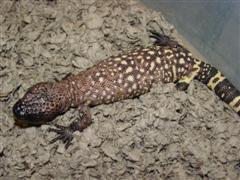Beaded Lizard
Mexican Beaded Lizard Scientific Name: Heloderma horridum
Sat, 19th July, 2025 - 2:37 am GMT
Sponsor Ads:

Alternative Name
Mexican Beaded Lizard Scientific Name: Heloderma horridumBasic Info
Beaded Lizards are covered in tiny, shiny, raised bumpy scales that look like polished beads. These are generally black with orange, yellow, or pink accents. The head and the feet of a Beaded Lizard are usually solid black. Their short, thick tails have yellow bands and there are poison glands located in the lower jaw. When the Beaded Lizard bites its prey, the poison flows in through the bite wound. Generally, Beaded Lizards grow to about two or three feet in length and can weigh up to five pounds. They have heavy, thick bodies and are stocky in appearance.
Health
Although Beaded Lizards use their venom for self-defense or hunting and may bite a human if they feel threatened by him or her. You should see a doctor if you are bitten, since the Beaded Lizard is poisonous. Breeding Usually, Beaded Lizards will breed between February and March and lay their eggs about two months afterward. These oblong eggs will incubate for about six months.Habitat
Semi-tropical and hot, dry areas of Mexico along the Pacific CoastBehavior
One of the two lizards that are actually venomous, the Beaded Lizard is as lovely as it is dangerous to predators. These beautiful lizards are hardy and interesting to observe. In the wild, Beaded Lizards eat birds, lizards, various small mammals, and eggs. In captivity, they are usually fed a diet of mice. They generally are only active at night, and spend their time foraging for food. Beaded Lizards hide during the day in burrows, which they scoop out themselves. They will also stay underneath rocks, or in preexisting burrows or tunnels, resting during the hottest hours of the day. Beaded Lizards can climb and swim in addition to regular movement over dry land. Although Beaded Lizards do poison their prey, their venom is also useful to help the Beaded Lizard escape predators. If it bites an animal that is trying to eat it, its chances of getting away become much better. They have a bulldog-like bite and will clamp down and hang on. Beaded Lizards, also known as Mexican Beaded Lizards, are in danger of becoming extinct in the wild. They suffer from habitat loss and are often even suffocated in their burrows in slash-and-burn agricultural practices. Another problem is the over collection of the Beaded Lizard for the pet trade. There are several collections of Beaded Lizards held by large organizations, allowing for good genetic exchange. Beaded Lizards are a taxonomic mystery; it is thought there are four subspecies, but further study is requiredOrigin
MexicoHistory
Beaded Lizards are native to semi-tropical and hot, dry areas of Mexico along the Pacific Coast, although their range may occasionally extend further to the southwestern United States.Common Foods
N/ASponsor Ads:
"Ground which can be freely traversed by both sides is called accessible." -- Sun Tzu, The Art of War
Beaded Lizard
Coded by: BGID® | ALL RIGHTS RESERVED Copyright © 2000-2025
Disclaimer | Privacy | Report Errors / Contact | Credits


 Preparing For China. China is growing their military. China Military Technology - can it keep up with the US?
Preparing For China. China is growing their military. China Military Technology - can it keep up with the US?  versus
versus 

 versus
versus 
 This Thread is about the North Korean Military itself - the kind of army, navy, and air force they have.
This Thread is about the North Korean Military itself - the kind of army, navy, and air force they have. 
 versus
versus 
 versus
versus  versus
versus